Welcome back to Week 36 in my weekly reports analyzing the Covid-19 pandemic and its effects on the country and higher education. For those of you reading this on my blog, Off the Silk Road, I have also launched a newsletter, where these reports can be sent directly to your email each week. Click here to subscribe.
Last week, we examined troubling statistics from hospitals nationwide as the first vaccine doses were administered in the arms of Americans. This week, we will continue to shed light on a devastating round of hospitalizations and deaths and discuss the latest details on vaccine rollout.
A national look
“We want them infected.”
These are words in an email from then-science adviser Paul Alexander, sent to Health and Human Services assistant secretary for public affairs Michael Caputo and other senior officials in July. It details the Trump administration’s strategy to push “herd immunity” through the population, letting the virus run rampant in the younger generation while “shielding the vulnerable.” While we have seen evidence in recent months that the Trump administration has been advocating for this strategy, it is still incredibly horrifying to hear that mass infection was in the minds of our nation’s top policymakers.
This week, the United States passed 300,000 confirmed deaths from Covid-19. There was no national mourning period. There was no moment of silence to remember those we have lost. We have become numb to the numbers and we cannot let it be this way. A USA TODAY analysis found that if we lit one candle for every life lost and put a foot of space between them, we would nearly cover the reflecting pool at the National Mall.

This week, America saw some of its deadliest days in history and the death toll will only continue to rise as over 114,000 people are currently hospitalized for Covid-19. America is running out of nurses as LA County has 0% ICU beds available and the state has enacted its mass fatality plan, purchasing 5,000 body bags. Almost 1 in 100 Tennesseans has tested positive for Covid in the last week alone. Over the past month, about 5.9 million new infections have been identified. That’s 1 out of every 56 people in the nation. One American dies every 33 seconds.
The president has been missing in action at a time when Americans are dying, starving and in crisis. “I think he’s just done with Covid,” said one of Trump’s closest advisers in The Washington Post. “I think he put it on a timetable and he’s done with Covid. . . . It just exceeded the amount of time he gave it.” When history looks back on the Trump presidency, it will remember a so-called leader who has shown no responsibility or remorse in combating the pandemic and saving American lives.
Some Americans have chosen to write about their experiences with Covid-19 in an effort to convince their neighbors to care. “The medical team tells you to look away as they remove the ventilator, and you notice they are making noise to prevent you from hearing your person choking and gasping for air,” Sarah Finefrock writes in The Washington Post on losing her father. “Then, the room goes quiet.” Yet others still fail to grasp the severity of the pandemic. One couple in Texas this summer still had a wedding with a photographer, after the groom tested positive for Covid-19 the day before. “Oh, no, no, no, don’t freak out,” a bridesmaid said. “He doesn’t have symptoms. He’s fine. ” Sure enough, the photographer tested positive a few days later. “I have children,” she told a bridesmaid. “What if my children die?” The bridesmaid responded, “I understand, but this is her wedding day.” The crisis has perpetuated all aspects of society, as one in 8 Americans — 40 million people — lives in a community whose local public health department leader has resigned, retired or been fired during the pandemic. The mayor of a city in Kansas has resigned after supporting a mask mandate, saying that she was met with threats of aggression.
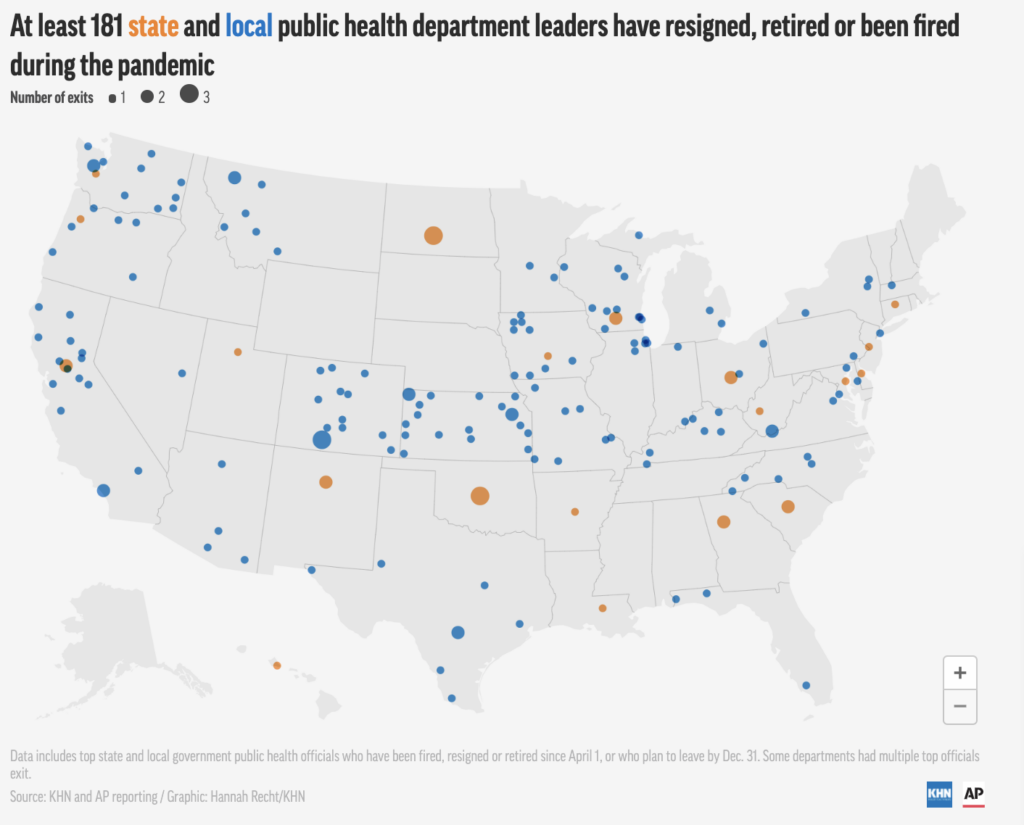
This week, the Department of Health and Human Services released a drove of data that shows most of the country in deep trouble. “The newly disclosed data reveal that nearly 900 out of 938 metropolitan areas and more than 2,000 out of 3,270 counties qualify as ‘sustained hotspots,’ meaning they have ‘potentially higher risk for experiencing healthcare resource limitations,’” the Center for Public Integrity’s Liz Essley Whyte reports. It is a major moment for transparency that Americans can now see the data specific to their community, and we owe our gratitude to the career scientists and officials who made this happen.
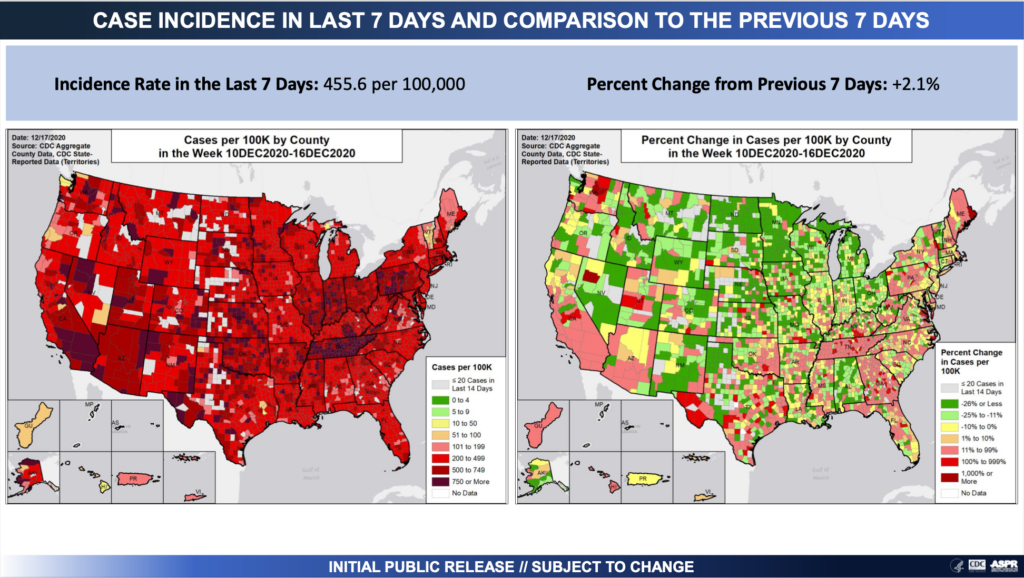
HHS data from this week shows the areas that saw the biggest change in Covid-19 hospitalizations between this past week and the one prior. This all comes as a new CNN investigation from Florida found that “After DeSantis signed the order initiating Florida’s final phase of reopening on September 25,… the state health department almost completely stopped sending tweets mentioning the virus” and a mystery gap in the death count occurred before the November election. The upcoming holiday season will only exacerbate our current issues.
Let’s take a look at some of the latest scientific developments:
- A CDC study from Vietnam found that mass quarantine with extensive testing helped curb a hospital outbreak.
- An analysis published in the Journal of the American Medical Association found that nearly 12,000 more people in the 25-44 age group died this year compared to previous years, underscoring that Americans of all ages can be impacted by the disease.
- A meta-analysis of 54 studies with 77,758 participants found that the estimated overall household secondary attack rate was 16.6%, higher than observed secondary attack rates for SARS-CoV and Middle East respiratory syndrome coronaviruses.
- A study published in Science with data from various countries found that closing all educational institutions, face-to-face businesses and limiting gatherings to 10 people or less each reduced transmission considerably. The additional effect of stay-at-home orders was comparatively small.
- A preprint suggests that superspreading for Covid-19 is substantial and based on behavior, but less than previously estimated.
- Findings from Singapore published in The Lancet found that asymptomatic Covid-19 cases are infectious but might be less infectious than symptomatic cases, by as much as four times.
- The FDA authorized two at-home coronavirus tests — one from Ellume and another from Abbott — which are major developments on the road to fast and affordable frequent testing. The Abbott BinaxNOW has high specificity and sensitivity when it comes to detecting infectious individuals.
- The UK has discovered a new mutation of the virus with higher transmissibility compared to original strains, but more research is needed.
- One in every five state and federal prisoners in the United States has tested positive for the coronavirus, a rate more than four times as high as the general population. In some states, more than half of prisoners have been infected, according to data collected by The Marshall Project and the Associated Press.
- A CDC report with data from children in Mississippi found that close contact with people with Covid-19, gatherings with people outside the household and lack of consistent mask use in school were associated with SARS-CoV-2 infection, whereas attending school or child care was not associated with receiving positive SARS-CoV-2 test results.
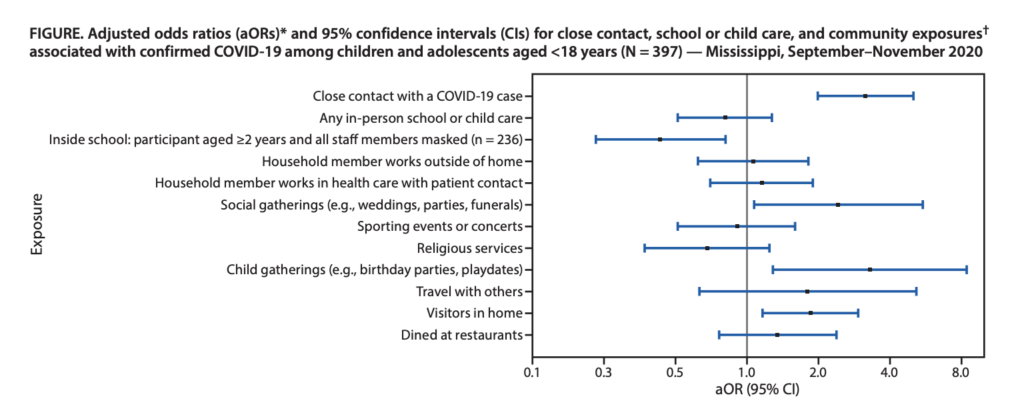
Finally, some updates on vaccines.
- As Pfizer’s vaccine has been already administered into the arms of hundreds of thousands of Americans, Moderna has received emergency use authorization for its vaccine and shipments will begin next week.
- “The careful scientific design and rigor has given us a great deal of confidence,” emergency physicians Megan Ranney and Esther Choo explain in a CNN op-ed. “All of this is why we are eager to take our place in line to get our shots — to protect ourselves, our patients and our families.”
- Germany has begun to erect mass vaccination centers.
- The concept of a “vaccine passport” has been met with skepticism. “We should resist the intuitive-seeming rush to give preference to vaccinated people for reasons of health, equity and public trust,” professor Nina Farahany writes in The Washington Post. “For now, the health secretary ought to limit the use of vaccine cards to their intended purpose.”
- Dr. Jesse O’Shea compares the side effects from the Pfizer and Moderna vaccines in a helpful table.

- Federal and state officials have yet to allocate a single shipment of Covid-19 vaccine to the National Institutes for Health, despite the agency — and its leading infectious disease researcher Dr. Anthony Fauci — playing a central role in developing one of those shots.
- Late this week, states were told by the federal government to expect fewer doses of the Pfizer vaccine next week, with some shipments cut by as much as half. On Thursday, Pfizer put out a statement saying that it was “not having any production issues” and that “no shipments containing the vaccine are on hold or delayed.” Operation Warp Speed’s General Gustave Perna has just taken sole responsibility for the error, which seems to have been an issue with the numbers recorded in the ordering system.
- For the past two weeks, I have been aggregating reports from all 64 vaccine jurisdictions on allocations and now distributions. You can track which states have reported changes in allocations, full dose allocations and vaccines administered in my Vaccine Allocation Dashboard here.
Let’s move on to our discussion of higher education.
Higher education
Each Friday, I update the College Watchlist, which is currently tracking 165,465 total cases at 96 colleges across the country. At the top of my list of cases in the last 7 days are:
- Texas A&M – 150
- University of Georgia – 148
- San Diego State University – 125
- Ohio State University – 117
- University of Florida – 114
A small number of schools have stopped reporting for the semester and 12 have indicated that dashboards will not be updated over the holidays. While the number of total cases this week (2,681) decreased from last week, the mean cases increased slightly.
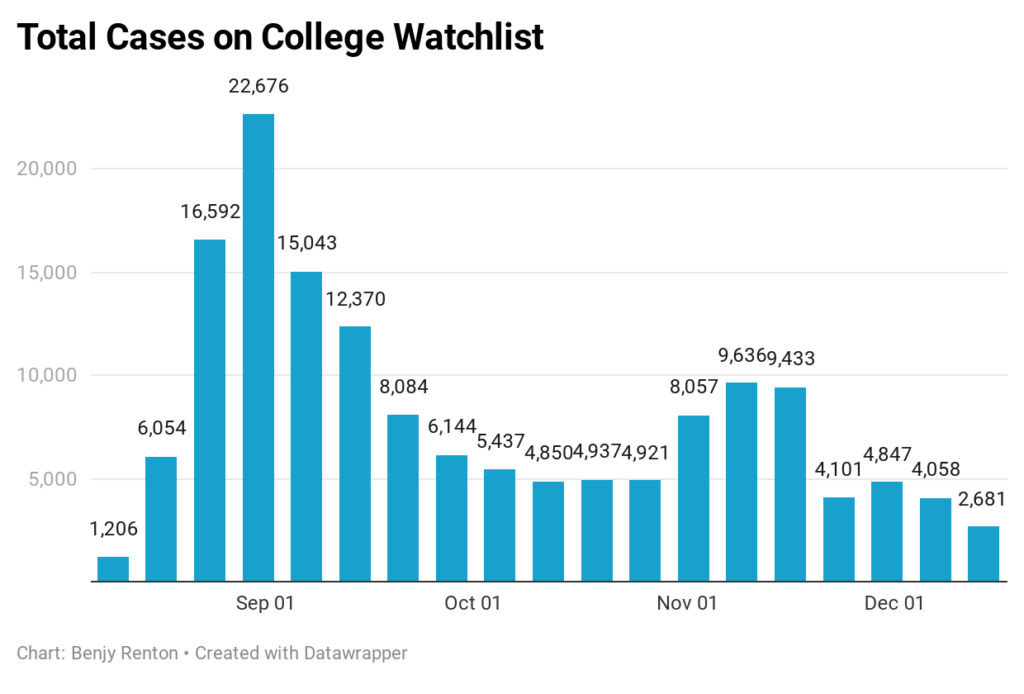
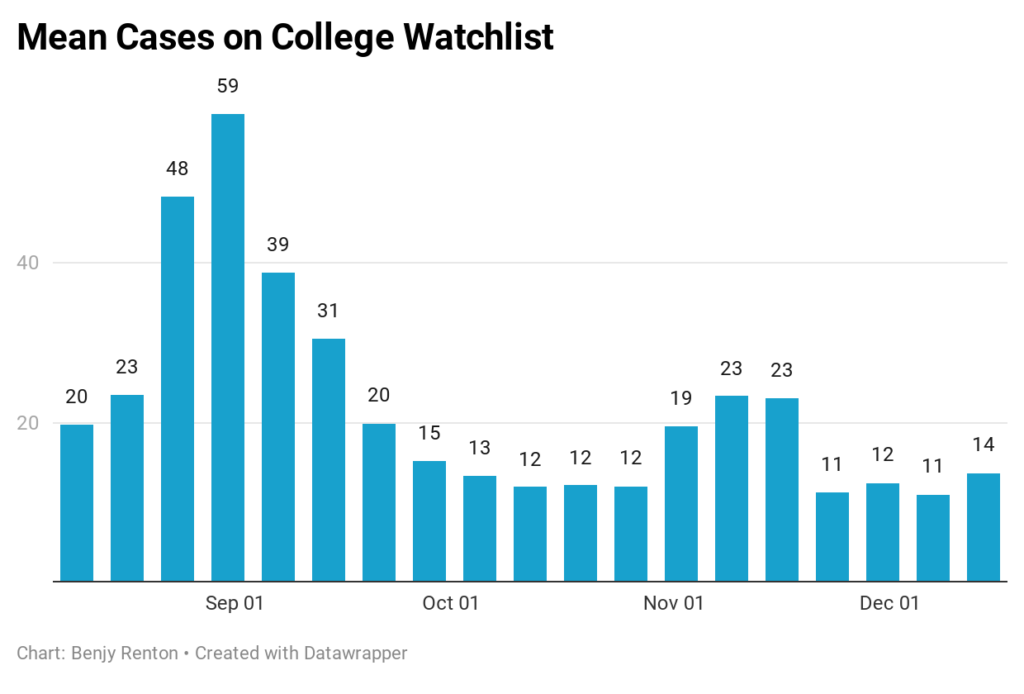
Here’s a roundup of this week’s higher ed news:
- Latest data from the National Student Clearinghouse Research Center found total college enrollment declined 2.5% this fall.
- “American higher education is now operating during the pandemic in a data void of its own creation,” education futurist Bryan Alexander writes in a piece drawing attention to the lack of a centralized database on Covid-19 cases at colleges this fall. “We are all forced to make decisions with a damnable paucity of information. We can, and should, do much better.”
- University of Houston men’s basketball Coach Kelvin Sampson revealed Thursday that every single player on his roster, 15 to be exact, has at one time or another tested positive for the coronavirus this year.
- Many students who returned home from college when the pandemic hit last spring drank far less alcohol than usual. According to a new study, published in the Journal of Studies on Alcohol and Drugs, alcohol consumption decreased substantially for students who had been living with their peers and then moved back in with their parents in the spring, when classes moved online.
- Higher education scholar Robert Kelchen highlights two issues colleges will face in the coming months: opening in January and possible vaccine distribution.
- “No one really talks to each other unless they already knew each other,” a student told The Washington Post’s education reporting team in its piece on the first-year experience.
- The Chronicle of Higher Education’s Nell Gluckman reported on one Cornell student’s experience, which underscores the need for colleges to ensure the health and safety of all their students. Stella Linardi fell ill with Covid-19 and had to navigate through many hurdles.
- The State Press’ Wyatt Myskow reported on Arizona State University’s fall semester. “It was stress-inducing; faculty felt voiceless; students failed courses for the first time; students learned little; there were no breaks to decompress; finals week was a disaster…”
- A new survey of over 200 colleges conducted by the American College Health Association found that 22% required testing before arrival, 37% required testing on arrival and 20% conducted regular asymptomatic testing. More research will be forthcoming shortly on the effects of these programs.
The Good Stuff
Let’s roll the clips of the good stuff. In my usual tradition, I feature my favorite stories from the week. Here are my Top 10.
- Sandra Lindsay, a critical care nurse in New York, was among the first in the nation to receive the coronavirus vaccine. “My grandmother’s just smiling right now,” she told The Washington Post. “She had no idea that I would pursue my dreams.”
- Houston Mills, a 26-year UPS employee and Marine Corps veteran, piloted the first batch of coronavirus vaccines from Michigan to Louisville.
- Videos of vaccine deliveries and administrations on the Internet are making people burst into tears.
- Vermont’s Seven Days published a list of anecdotes and reflections of gratitude from editors’ own lives and those of other Vermonters in a tough year.
- Dr. Fauci weighed in on Congregation Beth El’s debate on latkes vs. hamantaschen. His choice of sour cream as his favorite condiment angered Dr. Ashish Jha.
- The Columbia Journalism Review published its picks for best pandemic journalism this year.
- More people are opting to buy Christmas trees this challenging year than previous years.
- Want a fun and public health-oriented holiday craft? Here are some virus snowflakes to print out and cut.
- We can learn a lot about Pfizer’s vaccine shipment cold chain by examining shipping Dippin’ Dots ice cream.
- Taylor Blatchford published an incredible list of some of the best pieces of student journalism this year.
Conclusion
It is an incredibly jarring split screen to see vaccines being distributed to healthcare heroes while simultaneously watching more and more Americans succumb to Covid-19. The death toll will only climb in the coming weeks as the full effects of the Thanksgiving surge are realized. Compounded with holiday travel, mid-January will see overflowing hospitals and a continued cycle of infections. This holiday season, stay home. We must do all we can to alleviate hospital strain and keep as many Americans alive and as healthy as possible to receive the vaccine.
I’d like to thank all the student journalists with whom I have the pleasure of working. In the next weeks and months ahead, they will become vital in chronicling their colleges’ paths forward for the spring and beyond. Support their work by reading it.
My best to all for good health and wishing you a festive holiday season.
Like what you see? Don’t like what you see? Want to see more of something? Want to see less of something? Let me know in the comments. And don’t forget to subscribe to the weekly newsletter!
For more instant updates, follow me on Twitter @bhrenton.

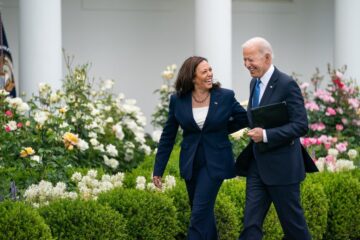

1 Comment
Malayka Gormally · December 20, 2020 at 9:52 am
Great newsletter, as always!
Comments are closed.